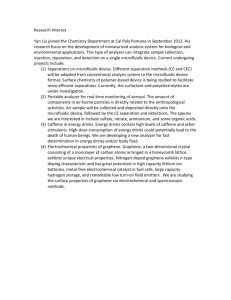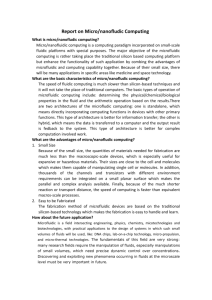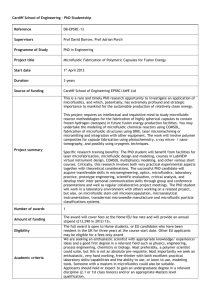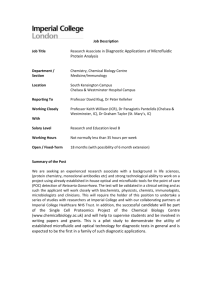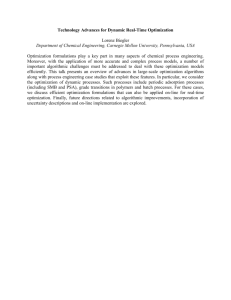Microfluidic_Simulation
advertisement
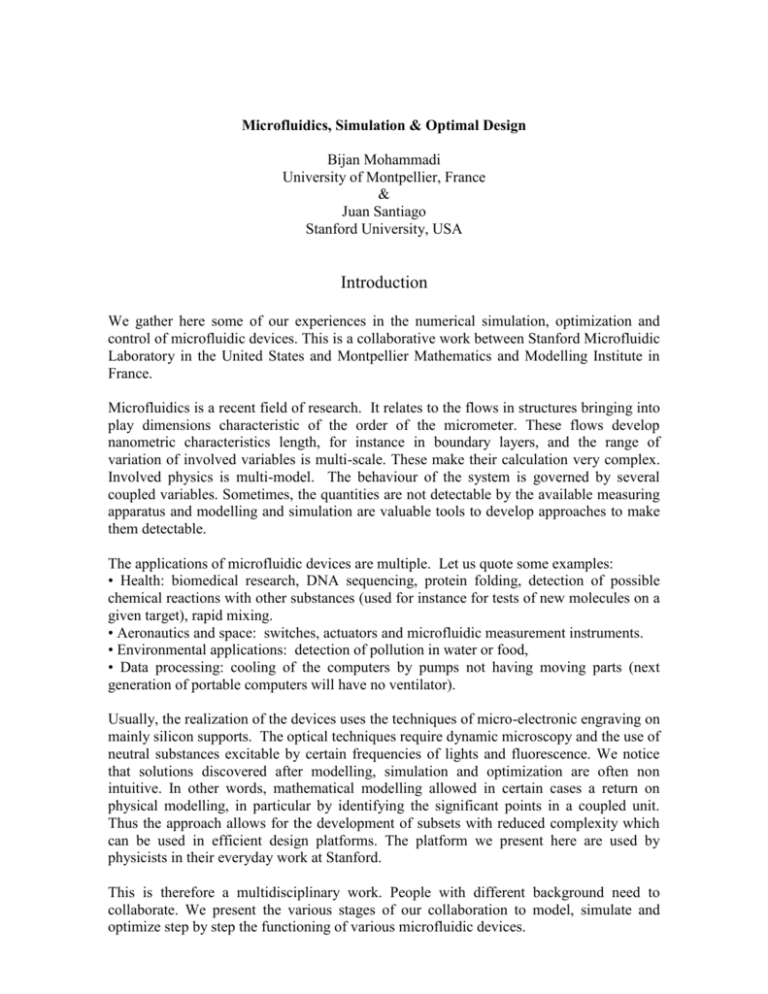
Microfluidics, Simulation & Optimal Design Bijan Mohammadi University of Montpellier, France & Juan Santiago Stanford University, USA Introduction We gather here some of our experiences in the numerical simulation, optimization and control of microfluidic devices. This is a collaborative work between Stanford Microfluidic Laboratory in the United States and Montpellier Mathematics and Modelling Institute in France. Microfluidics is a recent field of research. It relates to the flows in structures bringing into play dimensions characteristic of the order of the micrometer. These flows develop nanometric characteristics length, for instance in boundary layers, and the range of variation of involved variables is multi-scale. These make their calculation very complex. Involved physics is multi-model. The behaviour of the system is governed by several coupled variables. Sometimes, the quantities are not detectable by the available measuring apparatus and modelling and simulation are valuable tools to develop approaches to make them detectable. The applications of microfluidic devices are multiple. Let us quote some examples: • Health: biomedical research, DNA sequencing, protein folding, detection of possible chemical reactions with other substances (used for instance for tests of new molecules on a given target), rapid mixing. • Aeronautics and space: switches, actuators and microfluidic measurement instruments. • Environmental applications: detection of pollution in water or food, • Data processing: cooling of the computers by pumps not having moving parts (next generation of portable computers will have no ventilator). Usually, the realization of the devices uses the techniques of micro-electronic engraving on mainly silicon supports. The optical techniques require dynamic microscopy and the use of neutral substances excitable by certain frequencies of lights and fluorescence. We notice that solutions discovered after modelling, simulation and optimization are often non intuitive. In other words, mathematical modelling allowed in certain cases a return on physical modelling, in particular by identifying the significant points in a coupled unit. Thus the approach allows for the development of subsets with reduced complexity which can be used in efficient design platforms. The platform we present here are used by physicists in their everyday work at Stanford. This is therefore a multidisciplinary work. People with different background need to collaborate. We present the various stages of our collaboration to model, simulate and optimize step by step the functioning of various microfluidic devices. The following points are addressed: • Optimization of the extraction of microfluidic samples before their introduction in transport for separation or stacking devices. • Instationnarity control. • Stacking simulation and control to locally increase molar concentrations. • Shape optimization in microfluidic devices. • Modelling and optimization of rapid mixing devices used in protein folding. Arginine, MW = 174 Tag Alanine, MW = 89 Example of separation of two species in an electric field. Migration time and comparison with known tag permit to identify present species. Theory of control for the extraction of infinitesimal quantities Our collaboration around microfluids started with a problem of control of state. Indeed, before any analysis, it is a question of being able to extract a suitable sample from the solution to be analyzed. This sample must have certain geometrical characteristics with in particular very low dispersion. This is essential for the quality of the analysis as detection tools are highly sensible to the dispersion of the sample. Separation occurs during transport due to the difference of mobility of species in the electric field. Separation improves with the length of the channel and the intensity of the electric field. We will see that this former quantity cannot exceed some limit and that the required compactness of the devices (10 meters long channel on a support of 10 cm2) implies the introduction of turns. This leads to a shape optimization problem. xemples de systèmes uidiques pour analyse bio 10cm Microfluidic channel prototype made at Stanford Microfluidic Laboratory. The channel thickness is 5 microns. Affymetrix Caliper Technologies Initial extraction. The extracted band (in the right channel) will be transported for separation. In this example the initial band is not suitable for transport because of its geometric characteristics. We aim a band with minimum dispersion and with iso-contours as orthogonal as possible to the walls. If the extracted band has good geometric characteristics (the concentration gradient should be parallel to the electric field, which leads to iso-contours of concentration normal to the walls), it will be easier to proceed to a transport by electric field and the observation will be of higher quality. This is therefore a state control problem and we use control theory to address this issue using applied electric fields as control parameters. The solution of this problem by mathematic optimization produces control laws in time for the applied fields. This is performed accounting for realization and experimental constraint. Extracted band quality. After numerical optimization, the control law has been experimentally validated (numerical (above) and experimental (below) validation of the control procedure). Instability control is microfluidic flows Unsteadiness in microfluidic devices can be useful or harmful. When one looks for species separation it is important to avoid any alteration of the different fields. On the other hand, if one aims fast mixing, unsteadiness is mandatory for efficiency. Kelvin-Helmholtz type unstabilites appear, for instance, when the conductivity gradients are not parallel to the electric field. The perturbations are amplified with the applied electric field increasing. Perturbations are also sensible to local ions distribution in the flow and along the walls and therefore to their shapes. High electric fields are suitable as they improve separation and enables for the use of shorter channels. But, there is an admissible domain not to leave if one wants instabilities not to appear. Suitable or not, monitoring instabilities is a state control problem. Unsteadiness in microfluidic channels. We will see that this control problem is more difficult than the previous one. It requires a more detailed modelling of the physic of the problem. We need to solve the following set of coupled equations: Navier-Stokes equations for the velocity and pressure accounting for the electric field. Poisson equation for the electric field accounting for the presence of ions in the flow and also along the walls. Tranport-diffusion-reaction equations for the different species using the quantities above. We will see that an accurate solution of this ensemble is necessary. In the previous control problem only one electrolyte has been considered and an incomplete flow solution has been sufficient instead of the full set of Navier-Stokes equations. The double-layer has been modelled rather than computed. Hence, we model the effect of the walls on the flow rather than compute it. Prediction of the functioning range of a microfluidic device. In this case, the applied electric potential difference should not exceed 0.9 kV/cm to avoid apparition of unsteadiness degrading separation. Focussing and stacking One of the demands in microfluidic tests is to detect possible infinitesimal presence of species. Sometimes the level of this presence falls below the detection capacity of existing devices. One needs therefore to locally increase the concentration to make presences detectable. An example of such situations is possible small pollutions, not detectable at a given instant, but harmful by accumulation. Stacking aims to address this issue. One uses the fact that an ion sample passing from a region of high to another of low conductivity will accumulate at the interface between the regions. An analogy can be given with particules in a supersonic region placed before another subsonic. In the subsonic region the flow velocity is lower and therefore particules in the supersonic region will catch those subsonic at the interface. The simulation platform above developed for flow control can be applied to this problem. The interest goes to devices which enable to stack by a factor of 1000. One can hence differentiate two close samples having only infinitesimal differences. This is useful in genetic analysis where very small differences can produce large deviations. t =0 ms 50 m t = 278 ms t = 558 ms t =834 ms Numerical and experimental (in red) prediction of stacking. Numerical simulation is based on a low-complexity model not solving Navier-Stokes equations. Pressure gradient is neglected. This is observed in the right where the band bends due to pressure gradient. However, the phenomenon is detected. Most important, for small time intervals the prediction is very satisfactory. The simplified model can therefore be used efficiently in sensitivity analysis in optimization procedures. Design of microfluidic channels Another interest in this collaboration is to use mathematical shape optimization techniques. Separation increases with the length of channels and the applied electric field. We said that this former quantity is limited by experimental constraint and also to avoid flow instabilities. A too high electric field will also create too much heat by Joule effect. Important electric fields should also be avoided in presence of living organisms or any situation where it can modify the initial behaviour making the analysis unreliable. One should therefore increase the length of the channels. One the other hand, the whole channel should not occupy more than a few square inches (10 square cm) in horizontal space. This implies the use of turns every few inches in length. We saw above how to extract a suitable band for transport in an electric field with iso-contours normal to the walls. However, due to electric field variation in turns, we observe a skew in the band after a turn. The skew increases with the angle of the turn. This makes any analysis impossible after a few turns. One aims to find turns with shapes minimizing this effect. If such turns exist, one can build channels of arbitrary length with very small occupancy to length ratio. In particular, we are interested by 90 and 180 degrees type turns with which any configuration can be realized. Shape optimization for a 90 degrees turn. Left: numerical and experimental trials for a standard turn. Right: after optimization the skew has almost disappeared. Shape optimization for a 180 degrees turn. Experimental trials for the initial and optimized turns. On the left only one specie is present in the experience. On the second experience two species are present and separation is observed. The skew has almost disappeared. Numerical optimization has been performed with one species and the results remain valid in multi-specie configurations. Microfluidic mixing device design for protein folding Another application of interest is to build mixing devices for protein folding applications. These devices are used in biomedical research. One looks for different configurations in a ribosom chain having different behaviour in front the same situation. For instance, one might be interested in finding a protein reacting to the presence of a given virus. The optimization aims to control the folding time and in particular to reduce it. The final shape of the chain depends on the time it takes to fold the chain. Up to now the largest limitation concerns the treatment of times shorter than the molecular diffusion characteristic time. This time is proportional to the square of the length scale which implies a constraint on the size of the device. One would like to use other mechanisms involved than diffusion to reduce the folding time. In particular, we aim to take advantage of transport and pressure effects. We will describe how to achieve shape optimization for this configuration leading to mixing time far below what available from classical analysis. Optimal shape design reducing the mixing time for two species. The inlet channel has a diameter of 2 microns. Below on the left, the previous intuitive design and on the right the prototype built from the design obtained using optimization theory, 50 percent more efficient. Mixing time for the initial and optimized designs in micro second. Mathematical global optimization tools permits to find the global optimum for this mixing problem. This device is devoted to be at the inlet of an analysis one, such as those described above. Hence, one observes the results of a possible combination or reaction after transport in an electric field. Parallel trials permit to see the difference of behaviour for various mixing configuration leading to different protein folded configurations.
